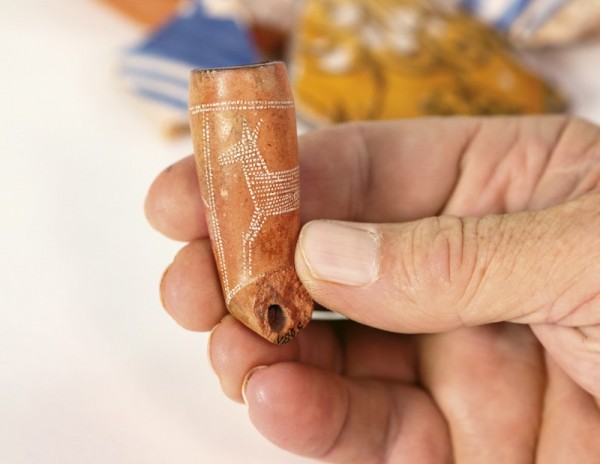
Pipe bowl, recovered from 44VB48, Virginia Beach, Virginia, ca. 1640–1680. Earthenware. H. 1 15/16". (Courtesy, Virginia Department of Historic Resources; unless otherwise noted, all photography by Brian Palmer.)
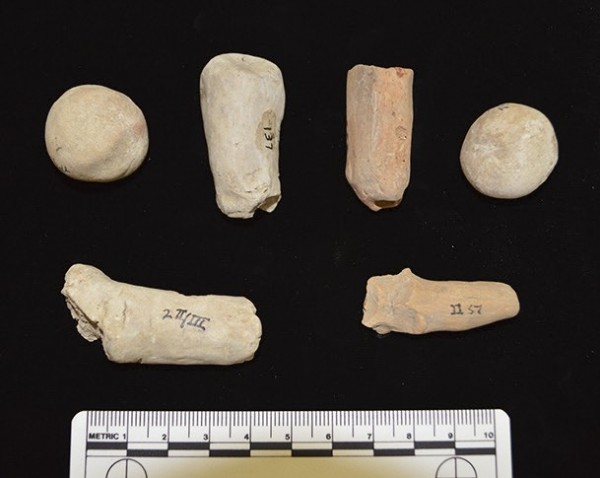
Pipe-making waste from the Nomini site (44WM12), Westmoreland County, Virginia, ca. 1650. (Courtesy, Virginia Department of Historic Resources; photo, Lauren McMillan.)
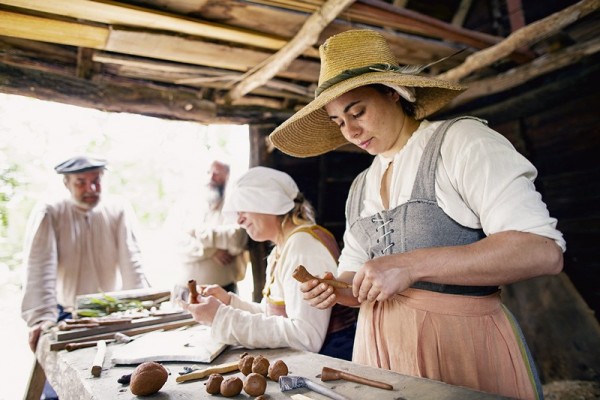
Often practiced by women, making pipes was an accessible craft which required only clay, a cane, and a fire.
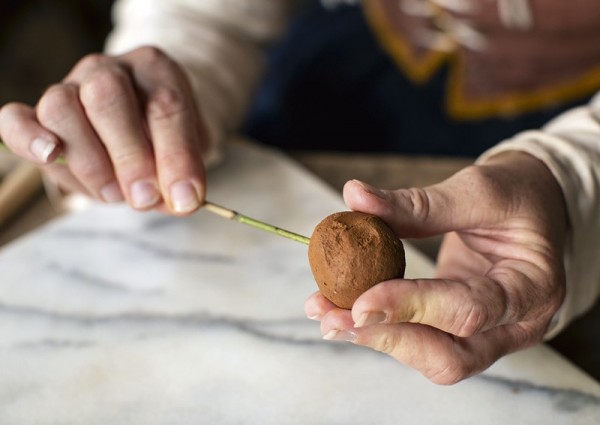
The process begins with clay as the most critical ingredient.
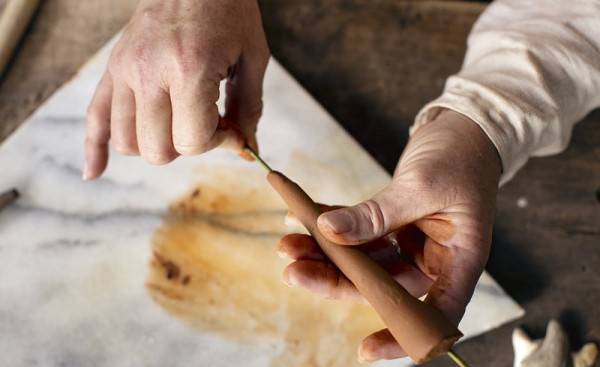
Shaping the tube pipe.

The tube pipe bends into an elbow.
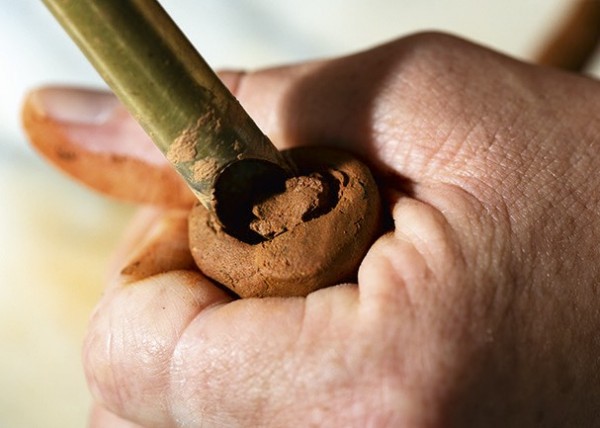
Excavating the bowl of the pipe.

Decorating tools are limited only by the imagination.

Unfired pipes believed to reflect the styles of Algonquian, Iroquoian, and probable Siouan pipe makers.
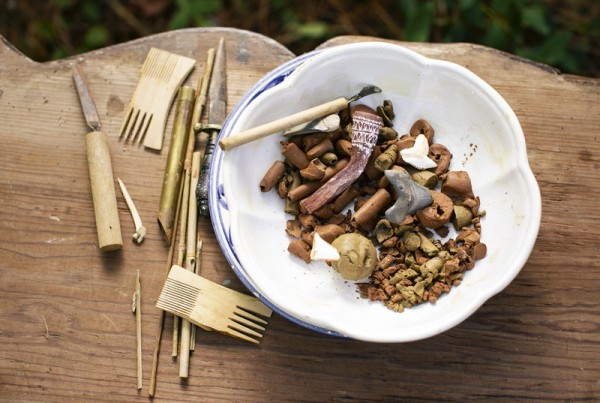
The tools and the trimming waste after making thirty-five pipes.

Ironically, pipes are tubes that can be fired in tubes.
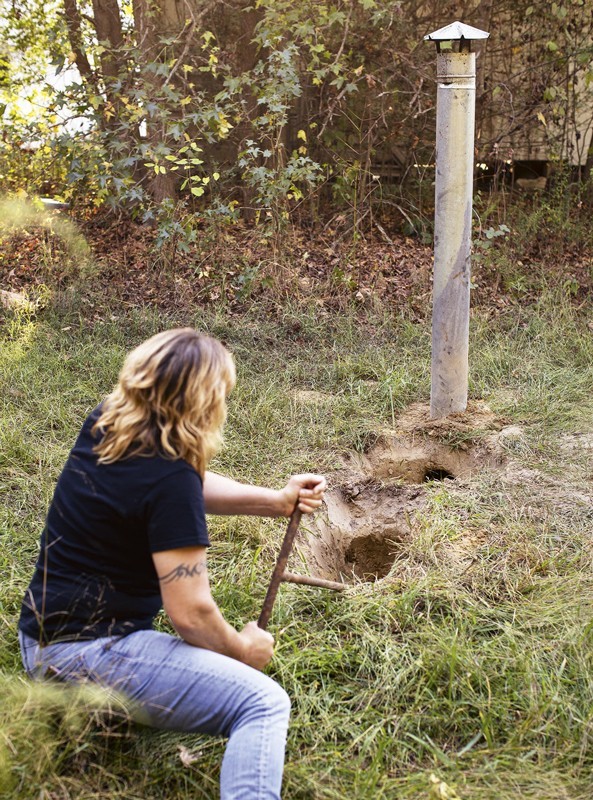
Augering the stoke hole.
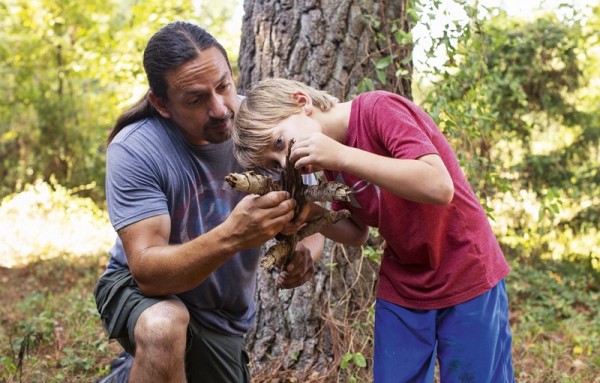
Pine knots provide the fuel.

Preparing to ignite the experiment.

Sealing the kiln.
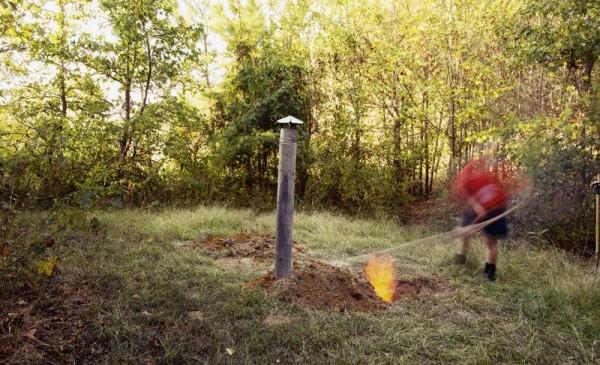
Fire in the hole, not the kiln.
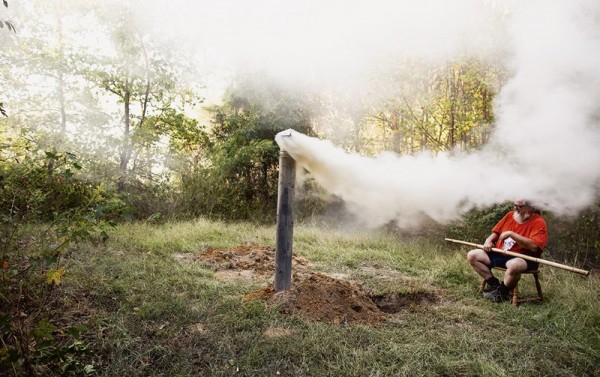
Life is an experiment, full of surprises.
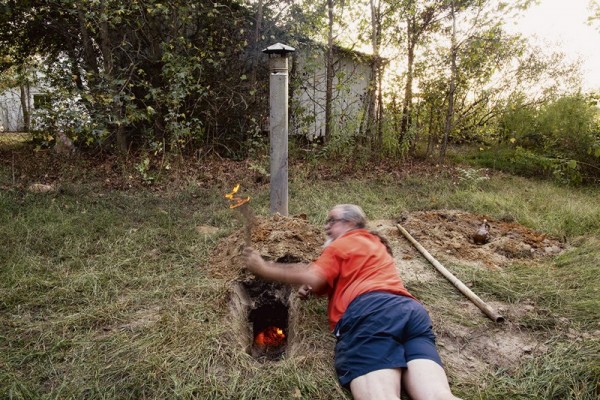
The dragon is alive.

Opening the big present on Christmas morning.

And . . . DISASTER.
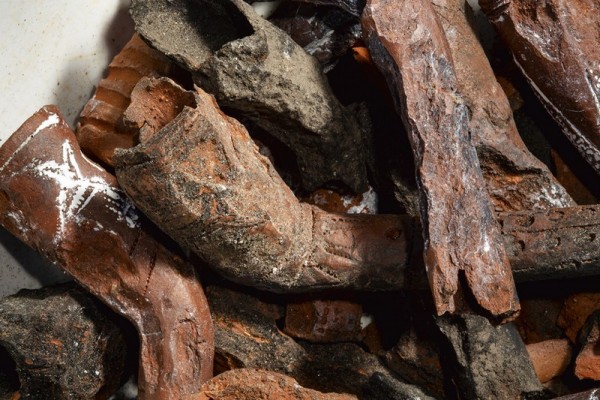
Grisly results—the bone fragments of cremated pipes.
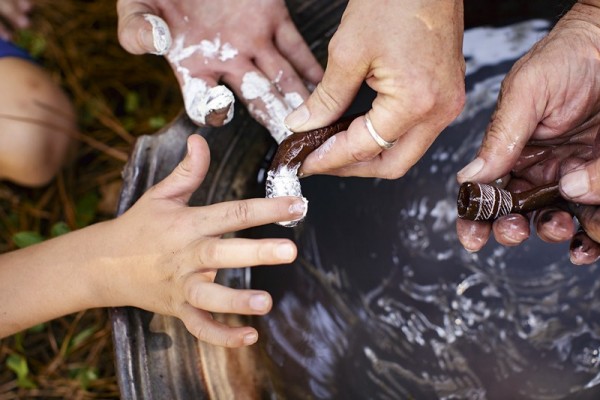
Revealing the secret of the white inlay.
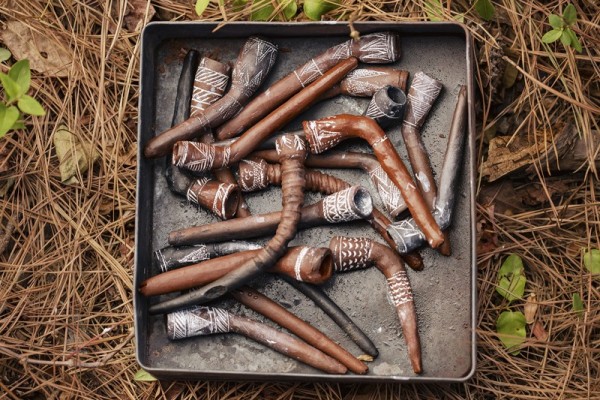
The latest harvest.
In 1984 author Taft Kiser began working at the historic plantation Flowerdew Hundred in Hopewell, Virginia, where archaeologist Matthew Emerson would conduct research for his dissertation on locally-made clay tobacco pipes in 1988.[1] Almost every day, the Flowerdew Hundred archaeological lab trays held dozens of pipes to be processed and debated.
Understanding that the most direct way to research a craft is to do it, Kiser began experimenting with clay. Since then he has baked tobacco pipes in campfires, barbecue grills, and, recently, in experimental kilns. A most important moment for him came in about 1999, in the collections storage room at the Virginia Department of Historic Resources, where boxes of material collected in a cornfield on the Potomac River known as the “Nomini” site (44WM12) were held (fig. 1). Those boxes contained bags upon bags of identical brown stems—the sheer number of stems suggested evidence of pipe making rather than debris from smokers. Better yet, although the stems had come from a colonial compound, the Nomini pipe maker was probably Algonquian, as the pipes are Algonquian in style.
Sites dating between 1640 and 1680 often have “possible pipe making waste,” usually a few odd clay chunks. A search of the Nomini boxes discovered the treasures pictured, waste from pipe making (fig. 2). The clay balls are probably pipe preforms. They appear to be too small for a Nomini bowl, which might be the reason they ended up in the fire. The throwers at North Devon’s Fishley Holland pottery knew, to the ounce, the amount of clay used in their pots, because apprentice Richard Coleman-Smith began each morning by weighing out and making up the balls for that day’s throwing.
The Nomini stems are known for their glossy finish and bores varying wildly from end to end. In his attempt to re-create these brilliant surfaces, Kiser first rolled stems on a rod. Unable to achieve the surface gloss, the experiment did suggest that irregular bore shapes and diameters seen in the original Nomini stems resulted from this production technique. This was a true eureka moment, since essentially all pipe-making literature suggests that stems were made by threading a bore wire into a mold. There is no mention of hand-building pipes on a rod. If Nomini’s primary pipe maker was Algonquian, this apparently indicates an undocumented traditional method. Europeans stamped clay out and pushed in airways, whereas here clay tubes were made and tweaked at the ends. It works, and what follows below is a description of hand-building pipes in that style.
Marking a Pipe
It takes roughly ten minutes to hand build a pipe and requires little besides clay and fire to create a product for sale (fig. 3). Europeans were molding pipes by the 1590s, but pipe molds may not have reached the colonies until about 1640. Using molds cut production time to less than a minute per pipe, but even if hand building, a person could make enough pipes over the course of a week to make it worth the effort of burning.
Nomini wasters indicate these makers created pipes on a cane, or a stem like woolgrass, tools that are easily improvised (fig. 4). Good clay must be hunted in creeks, river banks, and road cuts. Small size and low temperatures make pipes forgiving; the raw clay must be broken up, soaked, and kneaded a bit, but does not require temper, wedging, or other processing.
Stiffened by the cane, the ball is flattened into a tube pipe (fig. 5). Leaving the bowl thick, the stem is tapered down and drawn out. Burnishing levels out lumps and divots, and any scars are hidden by rolling until the surface is smooth. Rolling along a sharp edge creates the broad collars and bowls often seen on Iroquoian-style pipes.
Gripping the pipe and spinning the cane frees it from the clay and creates a broad airway. After withdrawing the cane, the bowl is adjusted to any angle desired. Because of their anthropomorphic shape, these are called “elbow” pipes, and may have originated with Algonquian pipe makers. They are found most often on the Coastal Plain from North Carolina to Delaware.
A useful practice is to have several pipes in process, shifting tasks as the clay dries. After bending the elbow, that pipe is set aside to harden (fig. 6). When dry enough to hold shape, the bowl can be excavated. The easiest means of excavation is a tube, such as an apple-coring tool (fig. 7). Although the surface has dried, the clay inside remains soft. Reinserting a cane into the bore keeps the airway open while the bowl cavity is cut down.
Archaeologist Stephen Potter has suggested that shark teeth were used to decorate pipes, while Silas Hurry and Henry Miller have pointed to combs; both have proven to be good decorating tools (fig. 8). Many objects make interesting impressions, and testing thus far has included lithic flakes, shell fragments, reeds, twigs, and catfish spines and other bones. The perfect tool is small enough for close work, with a projecting edge of 10–20 millimeters.
The unfired pipes illustrated in figure 9 are copies of archaeological specimens and interpretations of sixteenth- and seventeenth-century sources. Almost all of the stamped decoration comes from Algonquian parallels but includes a “tulip” bowl (a common Iroquoian form) and an Iroquoian-style “ring” bowl with an Algonquian-style Running Deer motif on the collar.
Making pipes produces relatively little waste—the dish illustrated in figure 10 holds all of the raw clay that was removed after rolling out and shaping thirty-five pipes. The waste consists of ends trimmed from bowls and stems, along with plugs and scrapings from bowl cavities. Unfired waste is normally thrown back into the clay bucket, since finding good clay is so difficult. The one vital tool is a grass stem or cane, but decorating tools can be almost anything.
Native Americans burned their pipes in pit firings, but this experiment used a more elaborate structure, borrowing from a 1620s bread oven at Flowerdew Hundred (44PG82). Colonists cut a firebox into a pit wall and capped it with a wooden arch plastered in clay. The wood burned away, but portions of the clay dome remained standing in the 1980s when it was excavated. That example, with a few modifications, became a cross-draft kiln—a tube with a fire hidden in the middle. The process begins by digging a firebox with a small tunnel leading in, and a small tunnel leading out (fig. 11).
Undisturbed earth would have provided most of the structure of the 1620s Flowerdew bread oven, but to fire the pipes for this experiment, modern stove piping supplied a chimney while an iron pan capped the firebox—either of which could have been fabricated from wood and clay in the seventeenth century. Figure 12 illustrates Laura Powell Kiser drilling the stoking port into the firebox at the mouth of the kiln. The firebox is still uncovered, but the metal chimney has been seated and its flue tunneled through to the firebox.
Colleagues participating in the experiment included Berek Dore, a Passamaquoddy, who is teaching his son Little Bear the traditional ways of the Algonquian peoples (fig. 13). Among the woodcraft are pine knots, which here were used to fire the pipe kiln. Resin concentrates in the heart of the tree, and particularly where branches shoot out. A pine tree lives for about a century, but after it has lived out its life cycle and returned to dust, resin-saturated “fatwood” can be found on the forest floor. These burn so intensely that they were used as torches.
Packed with pine knots and loaded with green pipes, the kiln is ready to cover and light (fig. 14). As it burns, air goes down the stoke hole and enters the firebox under the grate. The heat rises from the fire and passes through the ware and out of the chimney, creating a vacuum that draws more air into the stoke hole. In past firings, a metal box functioned as a saggar, shielding and protecting the green clay, but for this experiment about half of the pipes were placed on the open grate.
With the firebox loaded, the kiln is covered with a metal dome insulated with earth (fig. 15). Archaeological features tentatively associated with pipe making are generally basin-shaped pits containing pipe fragments, charcoal, and burned clay—which essentially is what would remain of this kiln after three centuries of typical soil erosion.
A cross-draft kiln is a tube. The firebox is packed with fuel, the ware loaded, and the dome sealed. Only the ends of the tube—the chimney and the stoke hole—remain open. The fuel sealed inside the firebox has to be ignited, which is accomplished by pushing burning twigs down the stoke hole (fig. 16). The flare of escaping flame shows the kiln has not come alive.
Different techniques are used for each firing. This kiln was a refinement on the previous kiln, which in turn was a refinement on the preceding kiln. In this firing, the firebox was packed with twigs and pine knots. When that fuel began to ignite, the firebox was too full and had insufficient air for a clean burn, so the kiln poured smoke (fig. 17). As the twigs disappeared, the air flow increased and the smoke faded away.
Air rushing down the stoke hole roars into the firebox, pulled by the hot exhaust rising up the chimney. Because of that flow, it is possible to reach down the stoke hole barehanded and pull out burning pine knots (fig. 18). Recording of temperatures has not been done yet, but a firing of about five hours seems adequate for these experiments. European pipes were fired at higher temperatures for longer periods of time.
The moment of payoff—opening a fired kiln is always exciting (fig. 19). After days of making pipes, an evening of firing, and allowing time for cooling, Kiser and Dore uncover the firebox. In a sense, it took thirty-five years of experimentation to reach this exact moment, demonstrating this process for Ceramics in America with photographer Brian Palmer recording each step.
Opening the firebox revealed a grisly scene of charred fragments that looked like a cremation (fig. 20). In the direct flow of the heat, the kiss of the flames exploded clay and sent fragments flying through the kiln. At the sides, pipes burned black but survived. Pipes shielded by the tin were fine, although a few shattered, probably from moisture.
Thermal shock blew huge chunks off the pipes that were exposed to the flame. Remarkably, even under the most pitted surfaces, the internal smoking tubes remained intact. Even with stems gone, most of the bowls could still be smoked (fig. 21).
One step remains after firing. Traces of white inlay survive on many seventeenth-century pipes. Archaeologist “Lefty” Gregory was also a pipe maker, and worked out a method of replicating that infill: once pipes are fired, the stamped decoration is rubbed with unfired white clay (fig. 22). Evidence indicates that the white infill decoration can survive for 350 years. The white inlay was added to the Running Deer after the firing, as a reminder of the pieces destroyed in the experiment.
The point of this research is not really to make pipes, of course, but to gain a better understanding of the people who made them. Except for Emanuel Drue, history essentially passes over this chapter of seventeenth-century America. Almost everything we “know” about pipe making comes from archaeologists interpreting artifacts excavated from the ground.
As author Al Luckenbach correctly observes: “We don’t really know any of this.” In this case, the most important technical finding seems to be that while Europeans molded pipes, it appears Algonquians rolled clay tubes. It is likely that shaping the clay on a cane was the traditional Native process.
The second important finding, another of Jim Deetz’s “small things forgotten,” is a tiny illumination of early colonial America.[2] While trades like blacksmithing required substantial investments, making pipes required only clay, a stem of grass, and fire, giving individuals with minimal resources the means to create a product for sale. By using patterns like hanging triangles or stars or dancing deer, the makers nearly always embraced their chance to add art and create something beautiful.
Matthew Emerson, “Decorated Clay Tobacco Pipes from the Chesapeake,” Ph.D. diss., University of California, Berkeley, 1988.
James F. Deetz, In Small Things Forgotten: The Archaeology of Early American Life (Garden City, N.Y.: Anchor Press/Doubleday, 1977).
